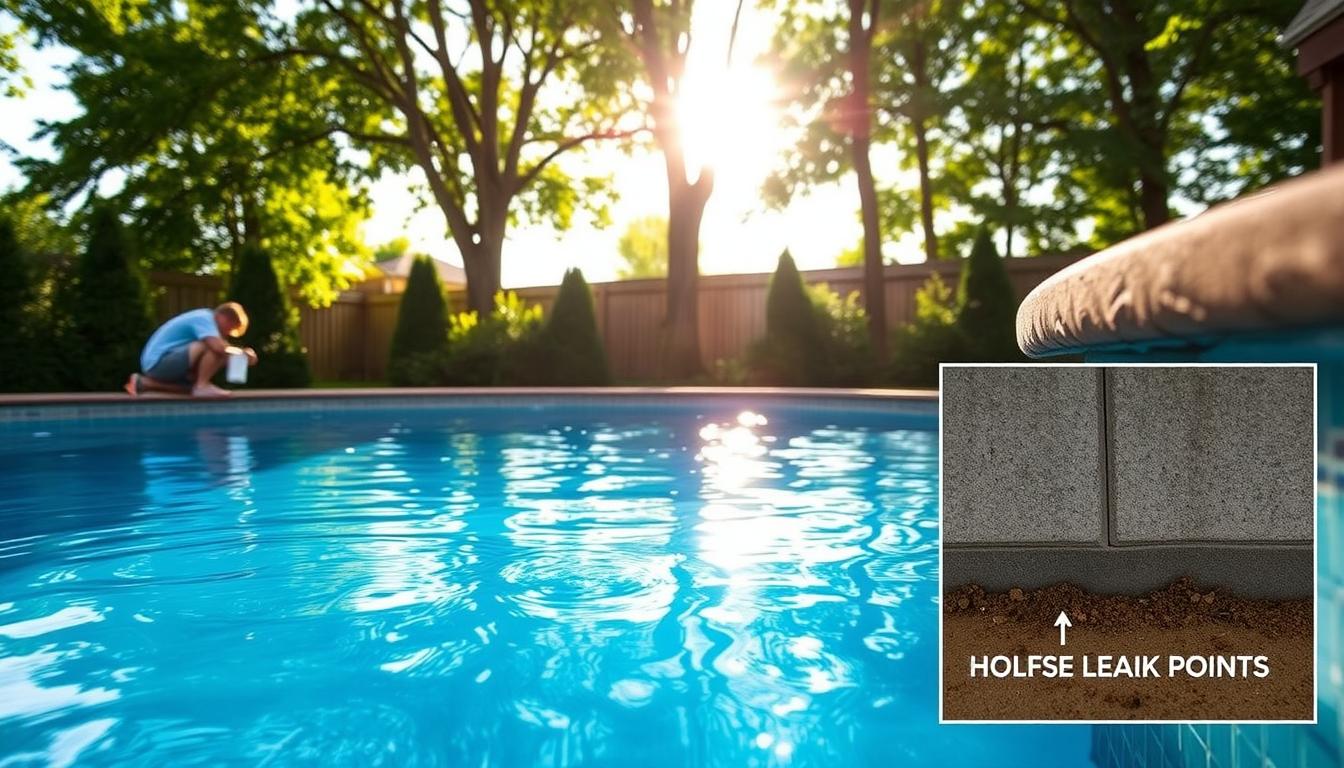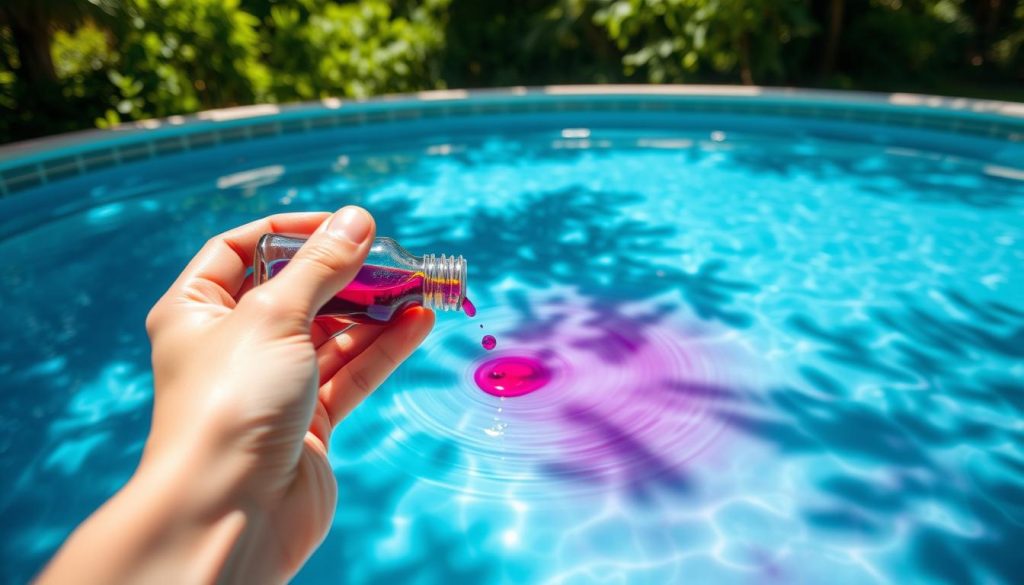
About 8% of American households have a private pool. Replacing an above ground pool liner costs around $2,327. But finding and fixing a leak is much cheaper.
You can locate and repair a leak for $10 to $40. The process usually takes 1 to 3 days. This can save you from expensive liner replacements.
Quick water loss in your above ground pool means you need to find the leak fast. Look for water leaking out, rapidly dropping water levels, and pooling around the base.
Wrinkles in the liner are another sign of a leak. To find it, do a dye test. Turn off the filtration system and wait for calm water.
Add pool leak dye or food coloring near the suspected leak area. Watch where the dye moves to find the leak’s location.
Once found, fix the leak with an underwater adhesive repair patch. You can also use a non-adhesive patch with PVC glue. These methods are quick and easy.
Key Takeaways
- Detecting and repairing a pool leak can cost as little as $10 to $40
- Signs of a leak include rapid water loss, pooling water, and wrinkles in the liner
- Perform a dye test to locate leaks in your above ground pool
- Fix pool leaks using underwater adhesive or non-adhesive repair patches
- Promptly repairing leaks can prevent costly liner replacements
Signs of a Leak in Your Above Ground Pool
Pool owners must watch for leak signs in above ground pools. Quick detection prevents costly repairs and keeps swimming safe. Knowing common leak indicators helps solve issues fast.
Water Level Dropping Quickly
A rapid water level drop is a clear leak sign. Losing over 1/4 inch daily likely means a leak. Some loss from evaporation is normal, especially in hot, dry climates.
A sudden, big drop should raise concerns. It’s time to investigate further when you notice this happening.
Water Pooling Around the Base of the Pool
Water pooling near the pool base is another leak sign. Check for wet spots on the deck or surrounding grass. These areas show where water escapes from your pool.
Look closely to find the leak source. Then take steps to fix the problem.
Wrinkles in the Pool Liner
Wrinkles in your pool liner can signal a leak. As water escapes, the liner may sag or wrinkle near the leak. Regular liner checks help spot potential leaks early.
This can prevent further damage to your pool’s structure. Look for any unusual changes in the liner’s appearance.
| Leak Indicator | Description | Action Required |
|---|---|---|
| Rapid Water Loss | Losing more than 1/4 inch of water per day | Investigate for leaks, perform bucket test |
| Water Pooling | Water accumulating around pool base | Inspect area to determine leak source |
| Liner Wrinkles | Sagging or wrinkled liner, especially near leak | Examine liner for abnormalities, consider patching |
Stay alert to these pool leak signs and act fast. This protects your investment and reduces water waste. Regular checks and quick action are vital for leak prevention.
Perform a Dye Test to Locate the Leak
A dye test helps pinpoint leaks in above ground pools. It uses dye or food coloring near suspected leak areas. By watching the dye’s movement, you can find the leak’s source.

Turn Off the Filtration System
First, turn off your pool’s filtration system. This keeps the water calm and still. With still water, you can see the dye’s movement better.
Ensure the Water is Calm and Still
Wait for the water to become completely calm after turning off the system. This helps avoid inaccurate results. Make sure there are no ripples or waves on the surface.
Add Pool Leak Dye or Food Coloring Near the Suspected Leak
Use pool leak dye or vivid food coloring like red or yellow. Put on plastic gloves to avoid staining your hands. Carefully drop dye near the suspected leak area.
Be precise when placing the dye. This helps minimize dispersion and keeps your view clear.
Observe the Direction of the Dye to Pinpoint the Leak Location
Watch the dye’s movement in the water closely. If there’s a leak, the dye will be drawn towards it. Keep adding dye until you clearly see the leak’s position.
This process may require patience and multiple dye applications. However, it’s a reliable method for finding leaks in above ground pools.
A dye test is a simple way to find leaks in your above ground pool. By following these steps, you can locate the problem and plan repairs.
| Test Type | Purpose | Procedure |
|---|---|---|
| Bucket Test | Determine if water loss is due to a leak | Compare water levels inside and outside a bucket placed in the pool |
| Dye Test | Pinpoint the exact location of a leak | Add dye near suspected leak sources and observe the dye’s movement |
| Pressure Testing | Detect leaks in the plumbing system | Pressurize the plumbing system and monitor for drops in pressure |
Patching the Leak in Your Above Ground Pool
Found a leak in your above ground pool liner? It’s time to fix it. Bestway offers an underwater adhesive repair patch for quick fixes. You won’t need to drain the pool water.
To use the patch, clean the area around the leak. Cut a circle from the patch to cover the damaged spot. Remove the film and stick it over the leak. Press firmly for 30 seconds to remove bubbles.
Wait 30 minutes before using the pool again. This allows the adhesive to set properly.
For larger leaks, try a DIY pool liner repair. Drain the water below the leak level. Clean and dry the area around the hole. Cut a vinyl patch to size.
Apply PVC glue evenly on the patch. Place the glued side over the leak. Press firmly for 30 seconds. Wait 30 minutes before refilling the pool.
For best results, apply the patch inside the liner. This lets water pressure help seal it tightly.
Regular maintenance can prevent leaks in above ground pools. Use a ground cloth and pool cover for protection. If you find a leak, repair is often simple and cost-effective.
Vinyl patch kits and pool liner repair kits are affordable. Find them at your local Do it Best store. Follow these steps to fix pool leaks quickly.
With proper care, you’ll enjoy your Bestway above ground pool all summer long. Don’t let leaks interrupt your fun in the sun.







